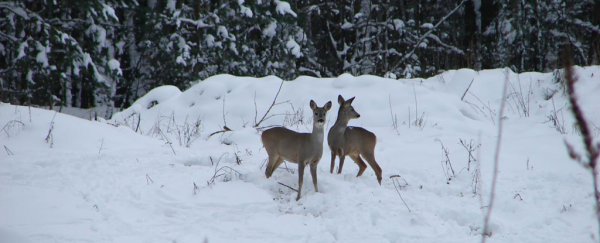When the Chernobyl nuclear disaster occurred in Ukraine in 1986, it wasn't just an environmental catastrophe for humans. The local animal wildlife took a terrible hit too, with the radioactive dust cloud that stemmed from the explosion killing or harming a huge number of animal species in the surrounding area.
But now, some three decades later, the animal population of the Chernobyl Exclusion Zone is positively thriving, despite the lingering radiation that still permeates the landscape. The sheer fact that virtually all of the area's human residents cleared out after the disaster, creating an impromptu wildlife habitat free from the negative impacts we usually pose to animal species, seems to have done them a world of good.
According to an international team of researchers, a resurgence in the numbers of elk, deer, boar, and wolves in the 4,200-km2 Chernobyl Exclusion Zone shows that the nuclear disaster in some ways had an eventual upside for the area's animal populations.
"It's very likely that wildlife numbers at Chernobyl are much higher than they were before the accident," said Jim Smith of the University of Portsmouth in the UK. "This doesn't mean radiation is good for wildlife, just that the effects of human habitation, including hunting, farming, and forestry, are a lot worse."
It's worth underscoring that the researchers' findings aren't an assessment on the impacts of radiation on the animals – they're simply an empirical measure of population numbers sourced from census data and helicopter surveys of the Chernobyl Exclusion Zone.
Those methods found that the populations of elk, roe deer, red deer, and wild boar in the radiation-affected area are comparable to the animal levels in uncontaminated nature reserves in the region. Wolf populations are particularly strong, being some seven times higher in the Exclusion Zone than surrounding reserves.
"These unique data showing a wide range of animals thriving within miles of a major nuclear accident illustrate the resilience of wildlife populations when freed from the pressures of human habitation," said co-author Jim Beasley of the University of Georgia.
While the researchers acknowledge that previous studies on the effects of Chernobyl showed significant detriment to animals and their numbers, they found no evidence of a long-term impact on population levels.
The study doesn't just show us how animals can bounce back in the face of radiation outbreaks imposed by events like Chernobyl and Fukushima. It's also a salient reminder of the adverse effects human habitation has on animals in their natural environment. Chernobyl was certainly toxic, there's no doubt about that – but in the long run, it appears the presence of people is even more threatening to animal populations.
"The results from these unique data will help society balance the negative impacts to wildlife from chronic radiation exposures against how 'the removal of humans alleviates one of the more persistent and ever growing stresses experienced by natural ecosystems'," the researchers write.
The findings are published in Current Biology.
